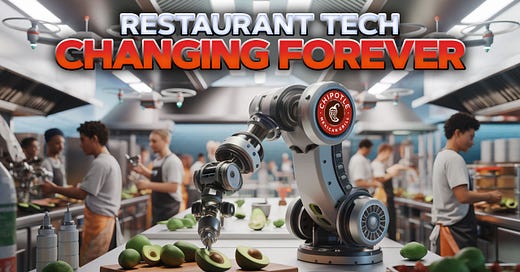Technology Is About To Change Restaurants Forever!
The restaurant industry continues to evolve rapidly, with major chains exploring innovative technologies to improve efficiency and sustainability. Chipotle recently unveiled new "cobot" (collaborative robot) systems that can peel and core avocados in just 26 seconds. This is part of Chipotle's broader innovation strategy, which includes investments in automated make lines and autonomous delivery vehicles. While such cutting-edge tech may seem out of reach for smaller brands, industry experts believe equipment costs will likely decrease over time, potentially making automation more accessible across the sector.
However, the fast casual segment is facing challenges, as evidenced by BurgerFi's recent bankruptcy filing. Despite having a quality product, BurgerFi has struggled with profitability and cash flow issues. This situation reflects broader trends in the industry, where many believe there has been overexpansion relative to population growth. Some analysts predict that 3-4 more major fast casual brands may face bankruptcy or acquisition in 2025, signaling a period of market consolidation.
The lines between quick service restaurants (QSRs) and fast casual concepts have blurred in recent years. QSRs are offering more premium menu items, while fast casuals are increasingly focused on speed and efficiency. This convergence is creating a more competitive landscape where brands must clearly differentiate their value proposition to succeed.
Economic pressures are also impacting the industry. With the Federal Reserve's recent interest rate cut potentially signaling concerns about the labor market, restaurants may face reduced consumer spending power. This could lead to shifts in dining habits, with some customers potentially "trading down" to more affordable options.
Franchising and refranchising strategies may play an important role for struggling chains. BurgerFi, for instance, is exploring selling off some company-owned locations to franchisees as a way to generate cash and reduce operational costs. This approach can provide capital for marketing, remodels, and technology investments without taking on additional debt.
Looking ahead to 2025, the restaurant industry faces both challenges and opportunities. While some brands may struggle or consolidate, others will likely find success through innovation, clear value propositions, and strategic adaptation to changing consumer preferences. The ability to leverage technology, control costs, and maintain brand relevance will be crucial factors in determining which concepts thrive in this evolving landscape.






